2021-2022 First-half season review
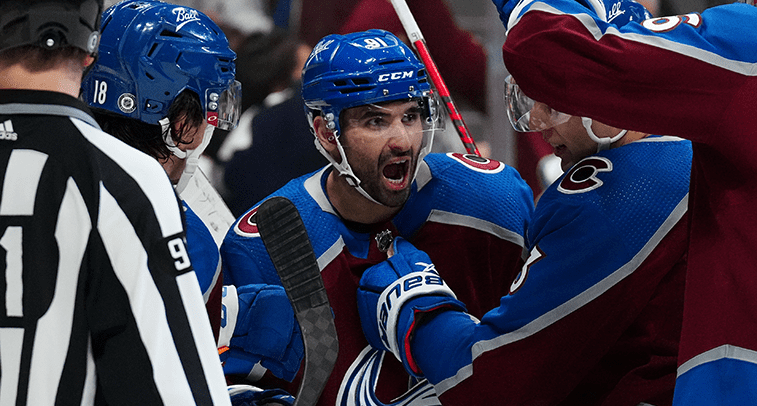
By: Philip Bulsink
The 2021-2022 season is just over half done – so it’s time to review again how things are going around the league! Just like last time, we’ll take a look at each team and evaluate how they’re doing compared to their original pre-season predictions.
These predictions came from the model developed by Philip Bulsink, which feeds the daily betting guides and which you can also check out on Twitter for predictions on how the rest of the season will play out. Before we get to the team-by-team review, we’ll start by giving a few awards to teams.
Team Awards
The first award we’re giving out is the ‘Vice Presidents’ Trophy’ – half of the Presidents’ Trophy power, for half of the season.
The team with the best record through 41 games is the Colorado Avalanche (30-8-3 through 40 games)!
With a mighty .768 points percentage and a completely dominant 19-2-1 home record, they’ve certainly been the team to watch out for in the West. The model has them flirting with a 50% chance to hold onto the top spot for the remainder of the season. Runners up here include Carolina (29-9-2 through 40 games), Florida (28-8-5 through 41 games) and Tampa Bay (27-9-5).
The next award is less prestigious. The ‘Race to the Bottom Award’ is bestowed upon the team with the fewest points through the first half of the season. Congratulations goes to Montreal Canadiens, who tallied only 23 points through 41 games. This drops them to the coveted position with the highest chance to pick first in the NHL Draft this July.
Montreal did risk its draft pick in the trade for Christian Dvorak with the Coyotes, but protected it from being handed over if they get a top-10 pick, which is likely.
Honorable mentions here go to Arizona (10-27-4 in 41 games), Seattle (13-24-4) and Buffalo (13-21-7).
Our third award today is the ‘Most Disappointing Award’, which goes to the Montreal Canadiens as well – with their 23 points, they’re sitting at only half of where they were expected to be by this point. Their success in making it out of the North Division last spring in the playoffs masked what was a team that struggled in 2020-2021 and gave the model some hope for their 2021-2022 campaign.
Unfortunately for Les Habitants, the season has not played out as many hoped and their woes have led to some reorganization in the front office. With only 36% of goals for (last in the league) and 46% Corsi For % (third last), they’re unlikely to turn things around soon.
After Montreal, both Seattle and Arizona are 16 points behind pace at 41 games and deserve mention here, too.
Finally, the ‘Biggest Surprise Award.’ This year, at 41 games, we have a winner with two close runners up: Minnesota Wild, with both Anaheim Ducks and St. Louis Blues close behind.
The Wild are 12 points ahead of where they were expected to be by the midseason, and the Blues and Ducks are both about 11 points above their expected pace. Minnesota has done a great job recently; the Wild are on a five-game win streak and are 8-1-1 in their last 10 games to get themselves atop this list. Meanwhile, our initial prediction for Anaheim was initially predicted to come in around 77 points.
But the Ducks are playing now to a 91-point pace, a surprise neck-and-neck with Edmonton and battling with Dallas and Los Angeles for a playoff spot.
On the other hand, St. Louis is on a 108-point pace (vs. the 90 points predicted) and, despite riding a PDO bump at 1.027 (highest in the league), look likely to be able to take home a playoff spot this spring.
Division By Division Review
Metropolitan Division
In the last review we finished in the Atlantic, so we’ll start here this time.
In that article, we noted the steady departure from expected pace by the Islanders. By the time they hit game 20, they’d already suffered from some significant COVID related issues. It seems now that they’ve been able to stop the losses, but they’re still hovering around that 10-points-behind pace. The Islanders have five games on hand to most of their divisional rivals and could make up some significant ground by winning those games. They’re the only bubble team in the East to have a pinch of a chance at making the postseason. They’ll need to win those five games in hand (and quite a few more) to expand that 8 percent chance.
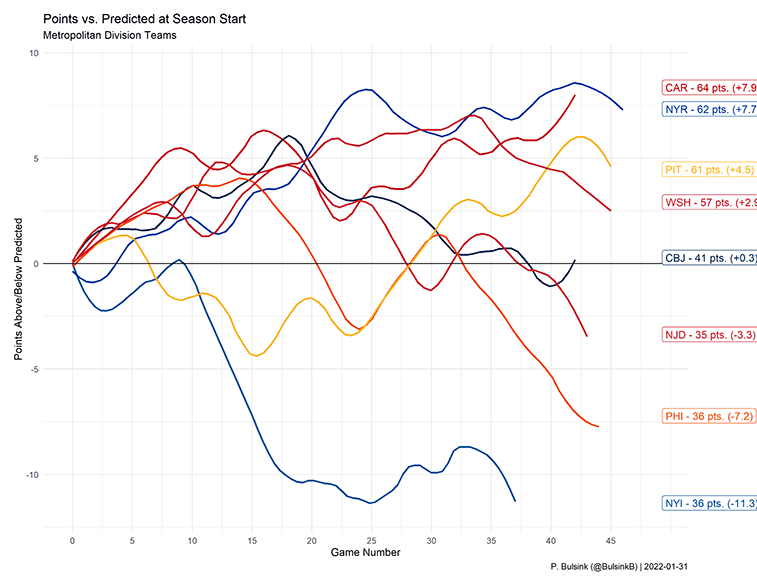
The Flyers have recently ended their second major skid of the season, which led to them being seven points off pace.
Pittsburgh continues its strong season after a rough start, while Columbus has played below the expected pace since game 16, losing any ground they built up early.
The Rangers have kept themselves looking very strong this season, despite being second last in All Situations Corsi For % (according to Natural Stat Trick). It will be interesting to keep an eye on whether they can keep that up.
Washington is 4-9 in overtime/shootout this season. If the Capitals can manage to turn some more of those close games in their favor, they can resume their above-pace season that they had until about game 35.
Atlantic Division
We’ve already talked about the Montreal Canadiens and their steady downward trajectory on pace. The season simulations that are posted daily on Twitter are expecting them to come in somewhere around 60 points – but this has one caveat.
The model assumes that teams will revert to the mean through the remainder of the season – this has shown to produce good results in back testing despite recent poor performance of any given team. But to assume that Montreal can crank out points at nearly double the pace that they have thus far is asking too much; the Canadiens are much more likely to land around 50 points (give or take a handful).
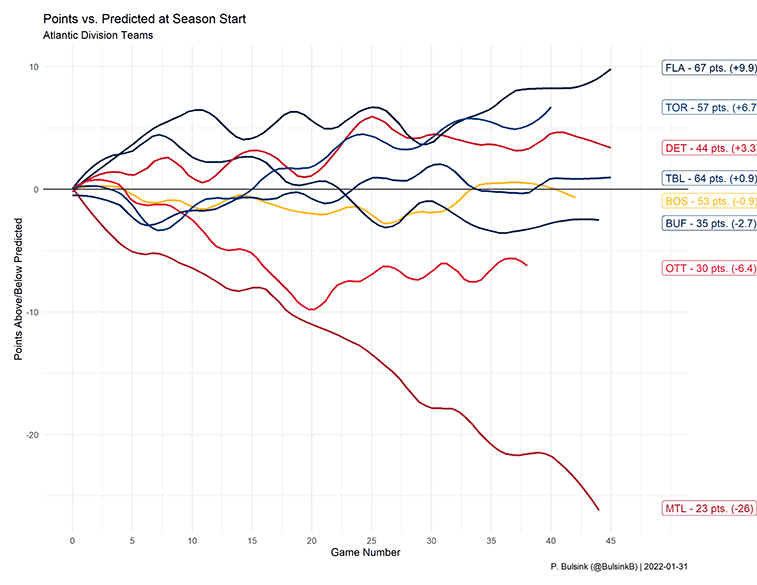
Beyond Montreal, we see that most teams have stabilized their paces.
Florida is up over pace by nine points now (vs. six points at 20 games) and Toronto is continuing its slow climb above pace as well (now about six points up from predicted).
Last time we mentioned Ottawa’s quick dive at the season start and noted its possible correction that began at game 20; this has held up and they’ve made a few points up on pace.
Central Division
This division has seen the biggest disparities between performance and prediction.
The Wild and Blues have already been discussed for outpacing their predictions quite handily, and the Coyotes were runners-up in how disappointing they’ve been (despite their low expectations).
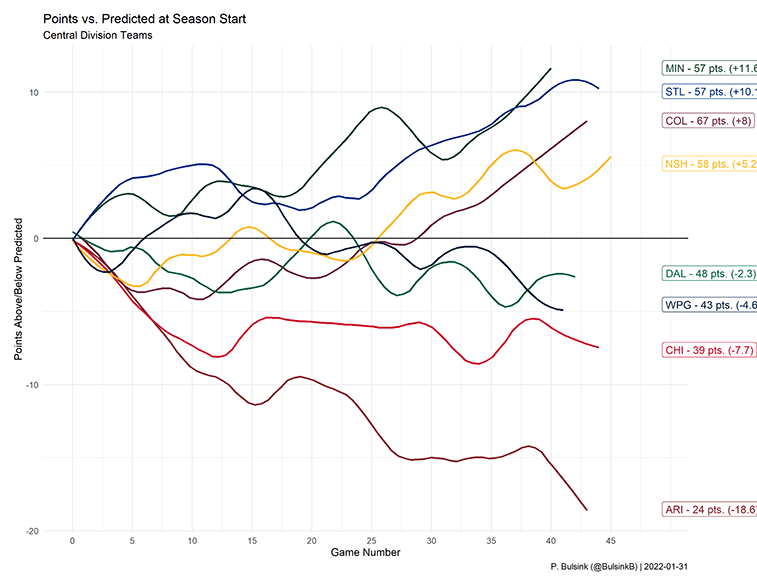
Colorado’s recent fortunes have highlighted the strength of its team, and the Avalanche have looked good even compared to their lofty predicted points haul. We’re at the point of having a predicted points total for Colorado potentially ranking amongst the top all-time, their 122 predicted standings points would put them seventh overall in NHL history. They’re playing such dominant hockey if you look at the win/loss records, but some of that is their soft conference rivals – they’re only ninth in the league for xG For %, 6th for Corsi For %, and riding a PDO bump nearly as large as St. Louis.
Other teams in this division have mostly held flat, except Nashville has found some good play since game 25 and added five points to its predicted total.
Pacific Division
Our Pacific highlight has to give credit to Anaheim for its strong season. While the Ducks weren’t predicted to do overly well by the model, their goaltending has been stellar, despite poor team defensive numbers) and Trevor Zegras and Troy Terry are putting up lots of points to take home key games. Their performance thus far has put them into playoff contention, particularly with a few other teams on the bubble struggling a bit.
Edmonton’s strong push from games 1-20 has been followed up by disappointment through the next 20 games, falling below pace (although hoping to have turned around again). This has put the Oilers neck-and-neck with the surging Ducks on the edge of that playoff spot.
Both are trailing LA (which has also out-performed expectations) for the third guaranteed playoff spot in the division. The wildcard spots are going to be very hotly-contested come April.
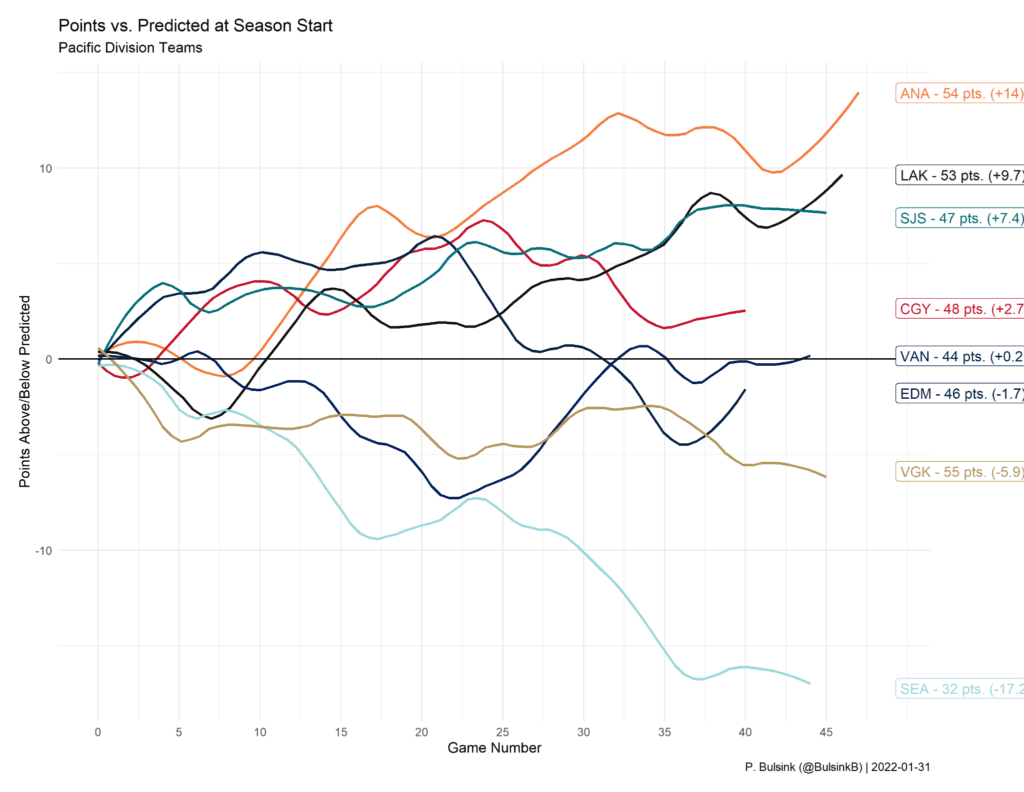
Elsewhere in the division, Vancouver has restored its season with their strong run from games 22 to 32. Unfortunately, it likely won’t be enough to get into the playoffs this year.
Vegas and Calgary have continued relatively flat since their early season jumps; but barring any major issues the model has them getting enough points for a playoff spot still, or even challenging Vegas for the division lead.
Next Up
In a few weeks the playoff picture will start to come into focus. In early March we’ll take a look at who’s likely to make it, who has a hope, and what teams’ chances are to challenge for the Stanley Cup.
Some teams are nearly certain to make the playoffs according to the model: Carolina, Florida, Tampa Bay, Toronto and Colorado.
Others are certain not to make it in: Montreal, Arizona, Seattle, Buffalo (and a handful of other Eastern teams).
But there’s still lots of hockey to play, and an interesting wildcard race heating up in the West!